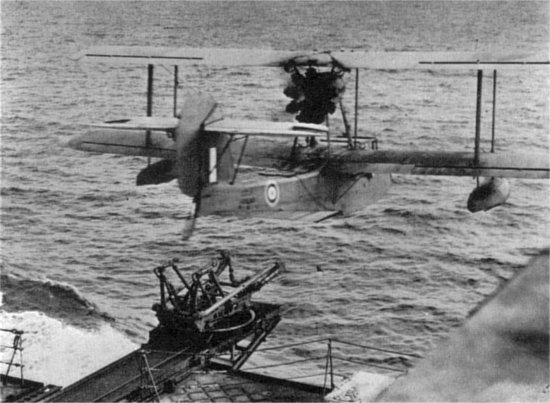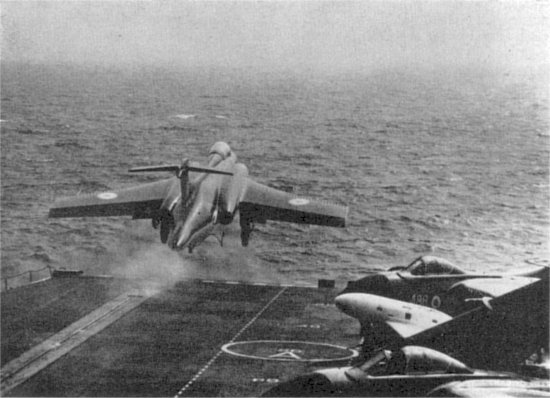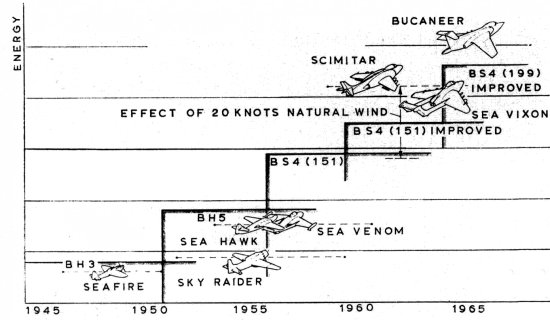Aircraft carriers - design and engineering, 1965
Catapults and arresters
[The Royal Navy's] world-wide commitments require us to operate a large variety of warships ranging from aircraft carriers to minesweepers. The aircraft carrier that is now being designed must be able to operate the present as well as the next generation of aircraft. These large, heavy and very costly weapons must be put into the air by catapult and recovered again by arresting gear. They must be maintained and serviced on board, and this requires workshops and highly skilled men with complicated test installations. For example, an expensive hydraulic installation must be fitted on board for testing aircraft systems, and the standards of cleanliness must be as stringent as those for the aircraft system itself. There must be starting air for aircraft, and low-pressure cooled air for the aircraft and pilot when they are under conditions of immediate readiness. Liquid oxygen of breathing purity must be provided, and large quantities of high-pressure air of clinical purity and dryness. A vast complex of radar and electronic equipment, requiring extensive cooling arrangements, is needed to control aircraft and to direct operations. Skilled crews must operate and maintain all this complicated equipment and they must be adequately supported in order to carry out this duty efficiently under difficult conditions. There must be air-conditioning to cope with climatic extremes and with wild heat from the powerful equipment on board, and increased refrigeration plant to cope with the change in messing arrangements (for frozen joints and vegetables are now being carried instead of carcasses and tinned vegetables). Chilled drinking water, laundries and all the paraphernalia of modern life must also be carried. These changes are not made merely to lap the modern sailor in luxury; the type of work to be done, the heavy usage, the need to improve the availability of all this equipment demands that living conditions for men on arduous duty and away from base for long periods fit them for their task. In the Andrew Laing Lecture [1] that I gave to the North East Coast Institution of Engineers and Shipbuilders in October 1964, there is a graph showing the rapid growth of installed electrical power in various types of ship. This sums up the growth of all these domestic and ancillary services in the modern ship, and illustrates the immensity of the design problem set by modern warfare.
|
Fig. 1: An early catapult launch of a Walrus seaplane from H.M.S. Edinburgh |
In previous surveys of naval engineering, little mention has been made of the very specialized machinery which is concerned with the launch and recovery of aircraft which operate from ships. This fascinating subject is worthy of a complete paper of its own, but my lecture would not be complete without reference to the engineering problems that have been overcome during the amazing development of naval air warfare.
The desire to assist by external means the take-off and landing of aircraft is as old as powered flight itself, for the Wright brothers experimented with a rudimentary form of catapult to help their first aircraft into the air. The problem for the Navy has always been to reduce the take-off and landing run, so as to launch and recover, within the confines of a ship, aircraft of performance comparable to that of shore-based types. The minimum penalty to the aircraft itself is therefore vital and this is achieved by limiting the airborne fittings to hooks at airframe strong points, and building machinery into the ship to supply energy for launching and to destroy it for recovery.
To launch a modern aircraft from an aircraft carrier it is necessary to accelerate it to a speed of approximately 150 m.p.h. in a run of about 150 ft, and this requires an acceleration several times that of gravity. This acceleration is limited not only by aircraft strength, but more generally by the physiological effects on the men inside. For many years, the latter prevented full development of the assisted launch, but in the last twenty years, brave experiments have lifted this limitation by proving that the human body can withstand, for short periods, the forces produced by high acceleration.
|
Fig. 2: A more recent launch of a Buccaneer aircraft from H.M.S. Victorious |
Developments of catapults started at about the end of the First World War to enable spotting aircraft to be launched from cruisers and battleships while under way, a cordite-operated type catapult being used for this purpose (Fig. 1). With the introduction of the aircraft carrier, the basic requirement was for an aircraft to be capable of free take-off from the deck, and a catapult was not therefore a necessity. Assisted take-off was, however, extended to the carrier in the form of an accelerator which was used under special but infrequent conditions. This was a hydro-pneumatic type which was under continuing development for service in all our carriers until a few years after the Second World War. The introduction of the jet propelled aircraft then began to demand the use of a catapult for every take-off, and it became apparent that the hydropneumatic type had reached the end of its development possibilities, and a new concept was required.
Today Britain leads the field in catapult technology and every aircraft carrier that operates modern fixed-wing aircraft is fitted with catapults of British design. These are slotted cylinder steam catapults, [2] invented by and developed under the direction of Commander C.C. Mitchell, O.B.E., B.Sc., R.N.V.R. The slotted cylinder principle is well known and was used by I.K. Brunel with very limited success in the early days of the Great Western Railway. In later days it was used by the Germans to launch their V1 missiles, but the development of the steam catapult has been its most successful application (Fig. 2). Many difficult problems were associated with this development. In particular, the catapult moving parts weighing about three tons had to be stopped at the end of launch in about five feet, and the cycle had to be repeated to launch aircraft at intervals measured in seconds. They were all overcome and present catapults operate very satisfactorily up to an equivalent of 25,000 h.p. As with all our equipment the rate of growth has shown the same pattern over recent years and this is illustrated in Fig. 3.
|
Fig. 3: Diagram showing increase in catapult energy |
Another vital piece of flight deck machinery which required extensive development was the arresting gear. The first deck landing was carried out in H.M.S. Furious in 1917. It was a free run landing with no attempt to stop the aircraft by external means. This method was used with varying degrees of success until the 1930's, when arresting gear was first used in the Royal Navy in order to exploit the considerable development in aircraft performance then beginning to take place. The gear consists of a transverse wire stretched across the deck which engages a hook that is lowered from the after part of the aircraft. The wire is pulled out against a resistance exerted by a hydraulic ram through a wire rope and sheave system, thereby absorbing energy from the aircraft and reducing its landing run. The treatment accorded to the wire rope during this process is severe in the extreme and its life is relatively short. It is subjected to very high impact loads, severe abrasion should the aircraft yaw at the moment of impact, high stressing due to bending round the narrow throat of the hook on the aircraft, and stress waves set up in the rope. The transverse portion is therefore made detachable. The remainder of the rope which is connected to the energy absorber has a much longer life, but the design problem is still severe and is increasing as the landing weight and speed of aircraft increase. An arresting gear of different arrangement and with considerable development potential was demonstrated publicly at the Royal Aircraft Establishment, Bedford, in August 1962. Two long thin cylinders are placed on either side of the runway, and the ends of the arresting wire rope are directly connected to a piston in each, so that the wire acts as a flexible piston rod. The cylinders are maintained full of water, and the energy of the aircraft landing is absorbed by the pistons expelling the water through small orifices in the cylinder walls as they are drawn along the cylinders. The spectacular result led to this device being called the 'Water Spray Arresting Gear'. This direct-acting type of gear has the advantage of simplicity, particularly for shore airfield use, where the water is lost, and where re-setting can be done in comparatively slow time. It is also being developed for possible use in aircraft carriers, if the problems associated with water recovery, rapid re-setting and marine atmospheric corrosion can be overcome.
[ Back ] Footnote 1: 'Post-War Developments in Naval Propulsion', Vol. 15, No.3.
[ Back ] Footnote 2: 'The Steam Catapult', Vol. 6, No.3, and 'A Steam Catapult Installation', Vol. 10, No.2.



